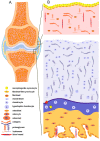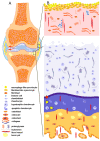Healthy and Osteoarthritis-Affected Joints Facing the Cellular Crosstalk
- PMID: 36835530
- PMCID: PMC9964755
- DOI: 10.3390/ijms24044120
Healthy and Osteoarthritis-Affected Joints Facing the Cellular Crosstalk
Abstract
Osteoarthritis (OA) is a chronic, progressive, severely debilitating, and multifactorial joint disease that is recognized as the most common type of arthritis. During the last decade, it shows an incremental global rise in prevalence and incidence. The interaction between etiologic factors that mediate joint degradation has been explored in numerous studies. However, the underlying processes that induce OA remain obscure, largely due to the variety and complexity of these mechanisms. During synovial joint dysfunction, the osteochondral unit undergoes cellular phenotypic and functional alterations. At the cellular level, the synovial membrane is influenced by cartilage and subchondral bone cleavage fragments and extracellular matrix (ECM) degradation products from apoptotic and necrotic cells. These "foreign bodies" serve as danger-associated molecular patterns (DAMPs) that trigger innate immunity, eliciting and sustaining low-grade inflammation in the synovium. In this review, we explore the cellular and molecular communication networks established between the major joint compartments-the synovial membrane, cartilage, and subchondral bone of normal and OA-affected joints.
Keywords: articular cartilage; chondrocytes; molecular signals; osteoarthritis; osteocytes; subchondral bone; synovial membrane; synoviocytes.
Conflict of interest statement
The authors declare no conflict of interest.
Figures



Similar articles
-
Gene Expression Profiling Studies Using Microarray in Osteoarthritis: Genes in Common and Different Conditions.Arch Immunol Ther Exp (Warsz). 2020 Sep 10;68(5):28. doi: 10.1007/s00005-020-00592-4. Arch Immunol Ther Exp (Warsz). 2020. PMID: 32914280 Review.
-
Osteoblast-chondrocyte interactions in osteoarthritis.Curr Osteoporos Rep. 2014 Mar;12(1):127-34. doi: 10.1007/s11914-014-0192-5. Curr Osteoporos Rep. 2014. PMID: 24458429 Free PMC article. Review.
-
Bone-cartilage interface crosstalk in osteoarthritis: potential pathways and future therapeutic strategies.Osteoarthritis Cartilage. 2014 Aug;22(8):1077-89. doi: 10.1016/j.joca.2014.05.023. Epub 2014 Jun 10. Osteoarthritis Cartilage. 2014. PMID: 24928319 Review.
-
Persistent synovial inflammation plays important roles in persistent pain development in the rat knee before cartilage degradation reaches the subchondral bone.BMC Musculoskelet Disord. 2018 Aug 16;19(1):291. doi: 10.1186/s12891-018-2221-5. BMC Musculoskelet Disord. 2018. PMID: 30115046 Free PMC article.
-
Gene expression analysis of subchondral bone, cartilage, and synovium in naturally occurring equine palmar/plantar osteochondral disease.J Orthop Res. 2022 Mar;40(3):595-603. doi: 10.1002/jor.25075. Epub 2021 May 16. J Orthop Res. 2022. PMID: 33993513
Cited by
-
Lipocalin-2 as a marker of inflammation, bone density, and triglyceride-glucose index for new-onset arthritis patients in Mosul, Iraq.Qatar Med J. 2024 May 6;2024(3):23. doi: 10.5339/qmj.2024.23. eCollection 2024. Qatar Med J. 2024. PMID: 38765271 Free PMC article.
-
Osteochondral organoids: current advances, applications, and upcoming challenges.Stem Cell Res Ther. 2024 Jun 21;15(1):183. doi: 10.1186/s13287-024-03790-5. Stem Cell Res Ther. 2024. PMID: 38902814 Free PMC article. Review.
-
Intermittent fasting in osteoarthritis: from mechanistic insights to therapeutic potential.Front Nutr. 2025 Jul 21;12:1604872. doi: 10.3389/fnut.2025.1604872. eCollection 2025. Front Nutr. 2025. PMID: 40761349 Free PMC article. Review.
-
Trace Elements-Role in Joint Function and Impact on Joint Diseases.Int J Mol Sci. 2025 Aug 2;26(15):7493. doi: 10.3390/ijms26157493. Int J Mol Sci. 2025. PMID: 40806618 Free PMC article. Review.
-
Recent advances in osteoarthritis research: A review of treatment strategies, mechanistic insights, and acupuncture.Medicine (Baltimore). 2025 Jan 24;104(4):e41335. doi: 10.1097/MD.0000000000041335. Medicine (Baltimore). 2025. PMID: 39854749 Free PMC article. Review.
References
-
- Safiri S., Kolahi A.-A., Smith E., Hill C., Bettampadi D., Mansournia M.A., Hoy D., Ashrafi-Asgarabad A., Sepidarkish M., Almasi-Hashiani A., et al. Global, Regional and National Burden of Osteoarthritis 1990-2017: A Systematic Analysis of the Global Burden of Disease Study 2017. Ann. Rheum. Dis. 2020;79:819–828. doi: 10.1136/annrheumdis-2019-216515. - DOI - PubMed
-
- Zheng S., Tu L., Cicuttini F., Zhu Z., Han W., Antony B., Wluka A.E., Winzenberg T., Aitken D., Blizzard L., et al. Depression in Patients with Knee Osteoarthritis: Risk Factors and Associations with Joint Symptoms. BMC Musculoskelet. Disord. 2021;22:40. doi: 10.1186/s12891-020-03875-1. - DOI - PMC - PubMed
Publication types
MeSH terms
Grants and funding
LinkOut - more resources
Full Text Sources
Medical

